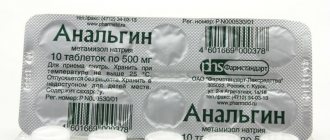Instructions for use ANALGIN
When using the drug, agranulocytosis may develop, and therefore, if an unmotivated increase in temperature, chills, sore throat, difficulty swallowing, stomatitis, as well as inflammation of the external genitalia and anus are detected, immediate discontinuation of the drug is necessary.
The risk of potentially severe anaphylactoid reactions to Analgin increases significantly in patients with:
- asthma syndrome or angioedema to non-narcotic analgesics;
- bronchial asthma with concomitant rhinosinusitis and nasal polyps, chronic urticaria,
- intolerance to dyes (tartrazine) and preservatives (benzoates);
- alcohol intolerance.
When prescribed to patients with acute cardiovascular pathology, careful monitoring of hemodynamics is necessary due to the hypotensive effect. Use with caution in patients with blood pressure levels below 100 mmHg. Art., with myocardial infarction, multiple trauma, with anamnestic indications of liver and kidney diseases (pyelonephritis, glomerulonephritis), during treatment with cytostatics, blood diseases. The risk of such reactions is also increased in patients with dehydration or dehydration, unstable blood pressure or incipient circulatory failure (for example, in patients with multiple injuries or a heart attack), in patients with high fever.
These patients require careful evaluation and close monitoring. Preventive measures (such as circulatory stabilization) may be necessary to reduce the risk of hypotensive reactions.
In exceptional cases, Analgin can be used in patients in whom a decrease in blood pressure is unacceptable, for example, with severe coronary heart disease or corresponding stenosis of the cerebral arteries. In such cases, the use of Analgin is possible only after careful monitoring of hemodynamic parameters.
In patients with renal or hepatic impairment, Analgin should be taken only after a careful assessment of the benefits, risks and necessary precautions.
In patients with an increased risk of anaphylactic reactions, Analgin can be used only after a thorough analysis of the possible risks in relation to the expected benefits. When taking Analgin in such cases, the patient should be carefully monitored to ensure medical care and emergency preparedness.
It is unacceptable to use the drug to relieve acute abdominal pain (until the cause is determined).
It is possible that the urine may turn red due to the release of a metabolite (it does not matter).
Impact on the ability to drive vehicles and operate machinery
The recommended dosage range does not affect the concentration or rate of reaction. As a precaution, avoid driving cars, vehicles, or other hazardous activities while taking high doses.
What we are treated with: Analgin. To numb the pain or defeat the disease
A scientific review of a popular painkiller
Why is one of the most accessible and well-known painkillers in our country dangerous, what types of pain is it effective against, how medical researchers fight for the lives of patients with pharmaceutical companies and with each other, why Sweden first banned Analgin, then allowed it, and then - she banned it again, read the material from Indicator.Ru from the section “How they treat us.”
Medicines designed to combat pain, fever and inflammation are among the most sought after on the pharmaceutical market. They are in any medicine cabinet and are often sold without a prescription in Russia, but in reality, many of them can seriously threaten health, especially if you do not first weigh all the pros and cons of such treatment and do not take into account risk factors.
The hero of today’s issue of the “How We Are Treated” column is the familiar Analgin - a cheap and accessible pain reliever and antipyretic. You may be surprised, but it is prohibited for sale in Western Europe and the USA, as well as several other countries.
From what, from what
The active ingredient in Analgin is called metamizole. It was first synthesized in 1920 by Ludwig Knorr, who is also known for discovering and studying several non-steroidal anti-inflammatory drugs, such as antipyrine; He was also interested in the properties of morphine and codeine. At the beginning of the 20th century, there were not as many rules and complex approval procedures for the drug as there are now, so the drug began to be produced just two years after its discovery. In the West, a drug based on metamizole is called Dipirone.
Metamizole molecule. Sulfur atoms are indicated in yellow, carbon in gray, oxygen in red, nitrogen in blue, and hydrogen in white.
Scientists have not fully established the exact mechanism of operation of this molecule, but metamizole presumably blocks the synthesis of prostaglandins in the brain and spinal cord. We have already told the heartbreaking story that the causes of pain and inflammation lie precisely in their incorrect behavior after meeting with the cyclooxygenase sisters in the article about Nurofen. However, Metamizole is not as hardworking as our previous heroes: he does not go to suppress the uprising of dissatisfied prostaglandins personally, but sends his derivatives. It was also not found to be associated with type 1 cannabinoid receptors located in the cells of the central system, which substances from hemp, as well as paracetamol, are blamed for. Although it most likely has some influence on this system. Other authors, on the contrary, argue that, although Analgin himself did not work there, his subordinate metabolites could well act on type 1 cannabinoid receptors at his “guidance.”
The Cochrane Collaboration reviewed our review, which looked at moderate to high quality studies assessing the ability of metamizole to help with post-operative acute pain. Despite the confusion, the review confirms that this drug really works.
The Cochrane Library is a database of the Cochrane Collaboration, an international non-profit organization involved in the development of guidelines from the World Health Organization. The organization's name comes from its founder, the 20th-century Scottish medical scientist Archibald Cochrane, who championed the need for evidence-based medicine and good clinical trials and wrote the book Efficiency and Effectiveness: Random Reflections on Health Care. Medical scientists and pharmacists consider the Cochrane Database to be one of the most authoritative sources of such information: the publications included in it have been selected according to the standards of evidence-based medicine and report the results of randomized, double-blind, placebo-controlled clinical trials.
Compared to placebo, which helped only 30% of patients, a single dose of metamizole 500 mg improved the condition of 70% of study participants. True, the authors still had doubts about comparing the active substance Analgin with other painkillers: the results were too ambiguous, and the patient samples were small.
The effect of Dipiron (Analgin) against acute attacks of pain (for example, after the removal of a wisdom tooth) and in renal colic has also been proven. In the latter case, scientists also proved that intravenous injections help better than intramuscular ones.
Side effects
Analgin can be dangerous in a completely different way: our granulocytes, one of the types of leukocytes, do not like it. Associated with them is a side effect of long-term use of the drug - agranulocytosis, that is, a drop in the level of granulocytes to 5% or even lower.
Granulocytes are granular leukocytes, white blood cells, which are characterized by a clearly visible nucleus and large granules inside. In every cubic millimeter of our blood you can find about 2-6 thousand of these cells. Their goal is to fight infections, or immune protection of the borders of our body. Agranulocytosis may be associated with the effect of Analgin on type 2 cannabinoid receptors.
There is scientific evidence to support this idea. Scientists from Germany, the USA and Italy prove that substances resulting from the breakdown of metamizole are able to bind both cannabinoid receptors. They also prove that these substances react with type 1 and type 2 cyclooxygenases both in vitro and in living tissue.
When the ranks of immune defenders are so thinned out, the body becomes vulnerable to many bacterial and fungal infections. Stomatitis, ulcers of the mucous membranes, fever, pain in the throat and joints are the first unpleasant manifestations of this condition. It can cause swelling of the larynx and even suffocation. This set of clinical signs can confuse the doctor, so it is not always possible to correctly determine the cause of these manifestations.
In case of complications, an atypical form of pneumonia occurs, which is difficult to diagnose due to the absence of cough and sputum, necrotic enteropathy (damage to the intestinal walls, pain and bloating in the abdomen, loose stools), which can lead to the death of the patient if bacteria from his intestines enter the blood . Also, with severe agranulocytosis, toxic hepatitis can develop - severe damage to liver tissue.
However, scientists continue to argue about how often taking Analgin leads to this disease.
The first articles about the dangers of Analgin began to be published back in the late 1960s, and one of them caused a stir among foreign doctors: according to this article, 0.79% of patients taking Dipiron also received agranulocytosis, and a third of patients with agranulocytosis died.
After this, Analgin-Dipirone was banned in the UK. The UK's example was followed by other countries where metamizole-based drugs disappeared from pharmacies in the seventies. At the same time, in Eastern Europe and Latin America, the same drugs were easily and freely sold, considering them to be safe analgesics. Therefore, the Europeans did not calm down and continued to look for evidence that would confirm the involvement of metamizole in the occurrence of agranulocytosis or justify the drug.
An international study was conducted, involving representatives from seven European cities and Jerusalem, but a large-scale search that lasted six years led to a rather modest figure: 1 case in 1.1 million patients per week. It looks like an excellent alibi, if you do not take into account that it included only patients in the hospital, and the controls were patients with agranulocytosis, from whom they were asked whether they drank metamizole. That being said, the case—the metric the scientists used—is quite unusual. If you recalculate the same data for a year, the figure will be completely different - 20,000.
Colleagues from Latin America saw a lot of bias in these studies: in their opinion, the risk estimates for using the drug were greatly overestimated. Thus, doctors from Sao Paulo did not find any particular dangers in the use of this medicine and stated that it, of course, increases the risk of developing agranulocytosis, but so weakly that this can be neglected without leaving people without an accessible medicine.
They also conducted another study, including Mexico and Argentina, but the results were the same. However, the author of the Russian review, Maria Avksentyeva, notes that this study was funded by a corporation that absorbed the producers of metamizole. In both studies, the risk of agranulocytosis was about half a person per million per year.
The Swedes also banned the drug. After a large-scale European project, they returned it to pharmacies again, but not just like that, but for the purpose of study. The indications became narrower: only for short-term use for renal and hepatic colic and acute pain after operations, and then doctors began to record side effects. Then the results convinced Swedish doctors that there was a danger, and in 1999 the drug was banned again.
The Dutch studied the effect of medications on agranulocytosis for 20 years, and they also considered metamizole dangerous for use. Library+will+be+unavailable+on+Saturday+01st+July+from+03.00-09.00+EDT+and+on+Sunday+2nd+July+03.00-06.00+EDT+for+essential+maintenance.++Apologies+ for+the+inconvenience), although in a small number of cases.
In a review from Barcelona doctors, metamizole took fourth place in the list of drugs that increase the risk of agranulocytosis, and for some reason no one is going to ban the winners from this “podium.” Leading the list, by the way, was methimazole, used to correct an overactive thyroid gland (that’s how important it is not to confuse the names).
In recent years, several more articles have appeared on this topic. The authors of another systematic review, examining 22 articles on the side effects of metamizole, also confirmed that the risk of agranulocytosis is increased, although its level varies greatly from one study to another. In another large study of a single dose of metamizole for post-operative pain, researchers assessed the drug's side effects in a group of 1,177 children under six years of age. The drug was administered once and intravenously, and no signs of agranulocytosis were found in patients. The same data for adults is confirmed by a review that assessed data from 79 studies.
Taking into account 77 reports from Switzerland and 1,417 international ones, the World Health Organization also summed up its conclusion: according to the conclusions of its experts, the risk is 0.46-1.63 per million person-days of use.
Thus, most of the results boil down to the fact that you should not use drugs based on metamizole for a long time, although, according to some data, a single dose may be relatively safe. Be that as it may, immigrants from Latin America to the United States continue to take metamizole illegally, swearing at local legislation, and some scientists suggest that the drug has a stronger effect on haplogroups common in Europe, so Latin Americans and Asians get much less.
Indicator.Ru recommends: can be used, but not for a long time
Scientific research data indicates the relative danger of the drug with long-term use, although not all scientists agree with this point of view. At the same time, in many developed countries the drug is either withdrawn from circulation or sold strictly according to a prescription, but in others it is freely sold, as in Russia. What to do? To be on the safe side, it is still better to heed the warnings and if you take Analgin, then do it for acute attacks of pain, but not for protracted, chronic pain. You can also make a choice in its favor if other painkillers do not help or are not suitable, but also do not get carried away with this drug and do not take it for more than a few days in a row.
Chronic use of analgesics can be dangerous: some, like many non-steroidal anti-inflammatory drugs, increase the risk of heart attack and gastrointestinal bleeding, others, like Analgin, can critically reduce the level of immune cells, a type of white blood cell, in the blood. And if this happens, you will become defenseless against a number of serious diseases, which can lead to pneumonia, hepatitis, and death at the end of this epic.
But always remember that numbing the pain does not mean defeating the disease itself. Therefore, it is better to try to find out the cause of the problem and eliminate it, if the pain does not go away after a couple of days, than to drink analgesics for weeks, turning a blind eye to a possible threat to your health not only from them, but also from the fact that while “treating” the symptoms you forget about the disease itself.
And if you still drink Analgin, listen carefully to your health: even severe stomatitis and an increase in temperature can be an alarming sign, after which it is better to go to the doctor and ask for a referral for a blood test so that these same leukocytes can be counted for you.
This article was published in the magazine “Idikator” on June 29, 2017.
Author: Ekaterina Mishchenko
Directions for use and doses
Inside, adults - 1 tablet. 2-3 times a day after meals. The maximum single dose is 1 g (2 tablets), daily dose is 3 g (6 tablets). With long-term (more than a week) use of the drug, monitoring of the peripheral blood picture and the functional state of the liver is necessary.
Children are prescribed 5–10 mg/kg body weight 3–4 times a day for no more than 3 days (after crushing the tablet).
Do not use (without consulting a doctor) for more than 3 days when prescribed as an antipyretic and for more than 5 days when prescribed as an analgesic.
Interaction
The simultaneous use of Analgin with other non-narcotic analgesics can lead to mutual enhancement of toxic effects.
Tricyclic antidepressants, oral contraceptives and allopurinol interfere with the metabolism of metamizole in the liver and increase its toxicity.
Barbiturates and phenylbutazone weaken the effect of analgin.
Analgin enhances the effects of alcohol-containing drinks.
Radiocontrast agents, colloidal blood substitutes and penicillin should not be used during treatment with metamizole.
Metamizole, displacing oral hypoglycemic drugs, indirect anticoagulants, corticosteroids and indomethacin from protein binding, increases their activity.
The simultaneous use of Analgin with cyclosporine reduces the level of the latter in the blood. Thiamazole and sarcolysine increase the risk of developing leukopenia. The effect is enhanced by codeine and propranolol (slows down inactivation).
Sedatives and tranquilizers enhance the analgesic effect of analgin.
Pharmacokinetics
Metabolized to form the main metabolite 4N-methylaminoantipyrine (MAA) and other metabolites - 4N-aminoantipyrine (AA), 4N-acetylaminoantipyrine (AAA) and 4N-formylaminoantipyrine (FAA).
Metabolites AAA and PAA do not have pharmacological activity. All metabolites have nonlinear pharmacokinetics; with short-term use, the accumulation of metabolites does not play a big role. Plasma protein binding is 58% for MAA, 48% for AA, 18% for FAA, and 14% for AAA.
Metamizole sodium crosses the placenta. Metamizole sodium metabolites pass into breast milk. Approximately 96% is excreted by the kidneys in the form of metabolites. After intravenous administration, the half-life of metamizole sodium is 14 minutes.
When high doses of metamizole sodium are administered, the kidneys may excrete a metabolite, rubazonic acid, which can turn urine red.
Elderly
In elderly patients, the area under the concentration-time curve increases by 2-3 times.
Liver dysfunction
In patients with liver cirrhosis, the half-life of MAA and FAA with a single dose of the drug increases approximately 3 times, the half-life of AA and AAA does not change. In such patients, high doses should be avoided.
Renal dysfunction
In renal failure, the rate of elimination of some metabolites (AAA and FAA) is reduced. In such patients, high doses should be avoided.
Side effect
Adverse reactions are classified as follows according to the World Health Organization (WHO) classification: very common (>1/10), common (>1/100 to <1/10), uncommon (>1/1000 to <1/100), rare (>1/10000 to <1/1000), very rare (up to <1/10000) and frequency unknown (cannot be estimated from available data).
Immune system disorders
Rarely: anaphylactic or anaphylactoid reactions.
Very rare: analgesic bronchial asthma.
Frequency unknown: anaphylactic shock.
Metamizole sodium may cause anaphylactic or anaphylactoid reactions, which in very rare cases can be severe and life-threatening. They can occur even if metamizole sodium has been previously used many times without any complications. Such drug reactions may develop immediately or some time after using metamizole sodium, usually within one hour. In milder cases, reactions manifest themselves in the form of skin and mucous membrane symptoms (itching, burning, flushing, urticaria, swelling); shortness of breath or patient complaints of gastrointestinal symptoms. In severe cases, they develop into generalized urticaria, severe angioedema (especially involving the larynx), severe bronchospasm, cardiac arrhythmias, a sharp decrease in blood pressure (which is sometimes preceded by an increase in blood pressure) and the development of circulatory shock.
In persons with analgesic bronchial asthma syndrome and intolerance to analgesic drugs, these reactions usually manifest themselves in the form of attacks of bronchial asthma.
From the blood and lymphatic system
Rarely: leukopenia.
Very rare: agranulocytosis (including fatal cases), thrombocytopenia.
Frequency unknown: aplastic anemia, pancytopenia (including fatal cases).
These reactions are immunological and can occur even if metamizole sodium has been previously used many times without any complications. Typical symptoms of agranulocytosis are lesions of the mucous membranes (oral cavity and pharynx, anorectal area, genital organs), sore throat, fever. However, when antibiotics are used, these phenomena may be mild. Sometimes, but not always, there is a slight enlargement of the lymph nodes or spleen. The erythrocyte sedimentation rate increases significantly, the content of granulocytes is sharply reduced or not determined. As a rule, hemoglobin, red blood cells and platelets remain normal, but deviations may occur. Typical symptoms of thrombocytopenia are an increased tendency to bleeding and the appearance of petechiae on the skin and mucous membranes.
If there is an unexpected deterioration in the general condition, the fever does not go away or ulcerations appear on the mucous membranes, especially the oral cavity, nose, and larynx, treatment tactics involve immediate discontinuation of the drug without waiting for the results of laboratory tests.
If pancytopenia develops, metamizole sodium should be discontinued and a complete blood count should be monitored until its values return to normal (see section “Special Instructions”).
Heart disorders
Frequency unknown: Kounis syndrome (allergic coronary syndrome, manifested by clinical and laboratory signs of angina caused by inflammatory mediators).
Vascular disorders
Uncommon: isolated decrease in blood pressure.
An isolated transient decrease in blood pressure is possible (possibly pharmacologically caused, and not accompanied by other manifestations of anaphylactic/anaphylactoid reactions).
Rarely: a sharp pronounced decrease in blood pressure.
With fever, a dose-dependent sharp decrease in blood pressure without other signs of a hypersensitivity reaction is also possible.
Skin and subcutaneous tissue disorders
Uncommon: fixed drug dermatitis.
Rarely: skin rash.
Frequency unknown: Stevens-Johnson syndrome, toxic epidermal necrolysis (Lyell's syndrome).
From the kidneys and urinary tract
Very rare: renal dysfunction.
Frequency unknown: interstitial nephritis.
In very rare cases, patients with impaired renal function may experience an acute deterioration in renal function (acute renal failure), in some cases with oliguria, anuria, proteinuria.
General disorders
Uncommon: urine may turn red due to the presence of a metabolite in the urine - rubazonic acid.
Overdose
Symptoms: nausea, vomiting, abdominal pain, decreased renal function/acute renal failure with oliguria (for example, due to the development of interstitial nephritis), less common central nervous system symptoms (dizziness, drowsiness, tinnitus, delirium, impaired consciousness, convulsions, coma) and a sharp decrease in blood pressure (sometimes progressing to shock), as well as heart rhythm disturbances (tachycardia), hypothermia, shortness of breath, acute agranulocytosis, hemorrhagic syndrome, paralysis of the respiratory muscles. After high doses, renal excretion of a non-toxic metabolite (rubazonic acid) may cause urine to turn red.
Treatment: There is no specific antidote. In case of overdose, forced diuresis is indicated. The main metabolite (4N-methylaminoantipyrine) can be eliminated by hemodialysis, hemofiltration, hemoperfusion or plasma filtration. With the development of convulsive syndrome, intravenous administration of diazepam and fast-acting barbiturates is indicated.
Contraindications
hypersensitivity to pyrazolone derivatives (butadione, tribuzone);
bronchial asthma;
diseases accompanied by bronchospasm;
"aspirin asthma";
inhibition of hematopoiesis (agranulocytosis, neutropenia, leukopenia);
severe liver or kidney dysfunction;
blood diseases;
hereditary hemolytic anemia associated with deficiency of glucose-6-phosphate dehydrogenase;
pregnancy (especially in the first trimester and in the last 6 weeks);
lactation period.
With caution - infancy (up to 3 months).
Overdose
Symptoms: with long-term use of the drug (more than 7 days) in large doses - nausea, vomiting, gastralgia, oliguria, hypothermia, decreased blood pressure, tachycardia, shortness of breath, tinnitus, drowsiness, delirium, disturbances of consciousness, agranulocytosis, hemorrhagic syndrome, acute renal and/or liver failure, convulsions, paralysis of the respiratory muscles.
Treatment: induce vomiting, perform gastric lavage, take saline laxatives, activated charcoal. In a medical institution - forced diuresis, hemodialysis, with the development of convulsive syndrome - intravenous administration of diazepam and barbiturates.









